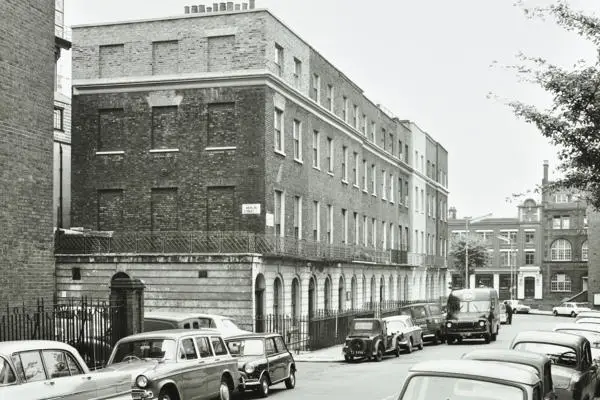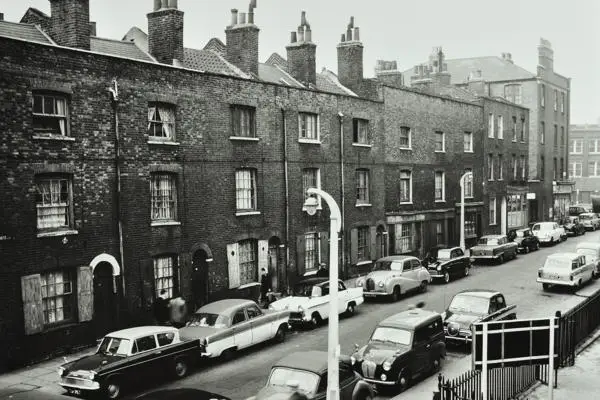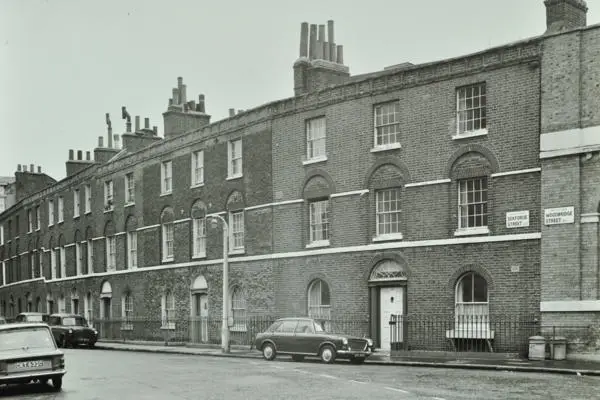Wilmington Square
LMA and its environs: Wilmington Square Clerkenwell in the 1960s
We are always delighted to hear from users who know and have researched the immediate environs of London Metropolitan Archives. Pamela Peskett, who moved with her family to Wilmington Square on the other side of Roseberry Avenue in the 1960s, reminisces about what family life was like in the local area then, referencing familiar and not so familiar local institutions such as the public baths in Merlin Street, the Pine Street Clinic, Treasure Island children’s public library in Tysoe Street, and Exmouth Market in this personal memoir.

We moved to Wilmington Square early in 1961 with our two year old daughter and lived there in a multi-occupied house until 1968.
It was a time of great social change during which Clerkenwell merged with Finsbury and in 1965 with Islington to create the present London Borough of Islington. Inner London had become seriously overcrowded and provincial towns such as Basingstoke were being developed in order to accommodate London's Overspill. In spite of the offer of better housing, many were loath to be separated from their local extended families.
Wilmington Square houses had been subdivided into flats and the residents were an ethnic and cultural mix. They included many Greek Cypriots, one of whom painted his house green over a weekend. The council stepped in and the colour washed off, but not before our son had picked it out on a visit up the newly erected Post Office Tower. On the plus side, we had around the corner in Rosebery Avenue a Greek patisserie which sold the most delicious honey-soaked cakes.
The house we lived in was owned by absentee landlords who did little by way of upkeep. A huge ear-like fungus grew in the bathroom, but they showed little concern. Years later when fire regulations were imposed and doors had to be fitted to every landing, it was dealt with and removed.
We shared the bathroom, a large room with a lavatory and a bath with a gas geyser (money in the slot), with the rest of the tenants. It was on the top floor next to our bedroom and above our living room and kitchen. Fortunately, other residents made a weekly visit to have a bath at the Public Baths on the corner of Merlin Street and the young couple in the basement, who had sole use of the garden/yard, had their own ancient bath with a table top. The bathroom doubled as a Labour Ward twice when my next two children were born in circumstances worthy of episodes of "Call the Midwife". In 1961 only first babies were born in a hospital; subsequent ones came under the local midwife and were born at home. In the days without the benefit of mobile phones midwives could be hard to reach as I found to my cost.
The Public Baths in Merlin Street were a boon for those without a washing machine. Built in 1931 and modernised in 1962 they contained not only a standard sized swimming pool and 90 ‘slipper baths’, but also a modernised wash house with huge washing machines (for coloured clothes or whites) and wide ironing belts for sheets and, if your folding was clever, shirts. Later, when I became a member of Islington Consumer Group, we surveyed Islington wash houses some of which still had metal sinks ,washboards and mangles! Sadly the Merlin Street baths were closed in 1988 and although public opinion was that the site should remain in community use and the council refused planning permission, it lost on appeal in 1994 and the site was used for private housing in a style some described as "illiterate neo-Georgian".
Another boon was the existence on the corner of our (south) side of the square with Tysoe Street, "Treasure Island" one of the first children's public libraries . The children were well catered for in the garden too. When first built in the 1820s the garden was private, but from 1885 it was bought by a benefactor and opened to the public complete with a fountain, drinking fountain and ornamental urns. G L Morris in the 1920s tells how on Saturdays the broad asphalt paths teemed with children, bare footed and booted. Children had to be with an adult and were not allowed on the grass. In 1931 a shelter was constructed where occasionally there would be a performance such as Punch and Judy or a conjurer arranged by the council, a relic of the wartime Holidays at Home entertainments. There was another playground with swings across Rosebery Avenue behind the Church of Our Most Holy Redeemer in Exmouth Market and the Pine Street Clinic with a small garden from where we could see the printworks,Temple Press, operating in Northampton Road. The building, constructed in the 1930s, later became the home of London Metropolitan Archives.

The Pine Street Clinic was another boon. Built 1935-8 it is now a 2 star listed building. The architect was Berthold Lubetkin famous for the flats he designed opposite Sadler’s Wells theatre, the Spa Green estate and the renowned penguin enclosure at London Zoo. The Clinic was open to all daily and many were the visits I made for advice when my children had minor complaints. However, there was a more serious event there during the smallpox scare when it was crowded out with rowdy people demanding vaccinations and they had none left. Our GP's surgery was in a former shop in Myddelton Street. It was a one man practice with no receptionist or appointment system, just a row of chairs to sit on while waiting to be seen. In 1966 there was an outbreak of Sonne Dysentery in the borough so all were tested and if need be treated with a strong antibiotic which in some children resulted in mottled teeth. The Sadler’s Wells theatre was a short walk away where one could put down a stool during the day to reserve a place in the gallery queue for the evening's performance .
Exmouth Market at that time was a regular street-market with market stalls, a grocer, butcher, a form of early supermarket and a jellied eel bar as well as a Woolworth's crammed in beside the church. The Church of Our Most Holy Redeemer although Anglican was very High (plenty of incense) so we worshipped elsewhere. Close by in Amwell Street there was a Roman Catholic Chapel, the Roman Catholic Church of Saint Peter and Saint Paul, which received an annual religious procession from St Peter’s Chapel down Farringdon Road in Saffron Hill with a figure of the Virgin Mary held aloft and many followers, possibly first communicants.
Nursery schools were hard to find but eventually we found one a short walk away . It was a Montessori school which had been started in the gatehouse of the Smithfield church of St. Bartholomew the Great by the educationalist Phyllis Wallbank. It was in Sekforde Street and our walk to it took us past a small enclosure where an old woman and a man, head to toe in black, sold paraffin oil which we needed for our heater. They were there in all weathers and I wondered whether they lived in the hut in the corner. Eventually they disappeared and we had to go for oil to a grim shop in Farringdon Road next to a Dickensian cobweb strewn shop which sold only cork and things made of cork. To the north the road changed its name to Kings Cross Road at the junction with Calthorpe Street where until 1960 had been a Rowton House. The building, still with its slits of windows, had reopened as a hotel. Little did the coach loads of tourists who arrive guess that it had recently been a home for down and outs as depicted in George Orwell’s novel "Down and out in Paris and London".

On the opposite side of Calthorpe Street stood the General Post Office sorting office - a huge building where once stood the Middlesex House of Correction, Cold Bath Prison known locally as the Steel. There was a small post office attached to the sorting office where my children weekly purchased their savings stamp to stick into their little books. These were eventually exchanged for savings certificates which came in very useful when funds were needed for school trips. The children loved watching the horses pulling their barrel-loaded carts through the square every day from the Whitbread Brewery in Chiswell Street, and to see them once a year at the great Cart Horse Parade in Regents Park bedecked with ribbons amongst pearly kings and queens.
With the introduction of parking meters in 1966 life became very difficult and so we made plans to move and eventually bought a house, with a garage, in a delightful city only an hour from London.
Further information
More about Wilmington Square can be found in the Survey of London, Volume 47, Northern Clerkenwell and Pentonville, chapter X. Survey of London Volumes 46 and 47 cover the wider area and can be accessed on British History Online.